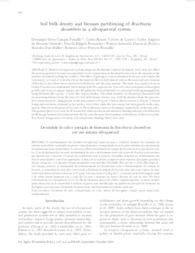Soil bulk density and biomass partitioning of Brachiaria decumbens in a silvopastoral system.
Soil bulk density and biomass partitioning of Brachiaria decumbens in a silvopastoral system.
Autoria: PACIULLO, D. S. C.; CASTRO, C. R. T. de; GOMIDE, C. A. de M.; FERNANDES, P. B.; ROCHA, W. S. D. da; MULLER, M. D.; ROSSIELO, R. O. P.
Resumo: Shade in silvopastoral systems improves the thermal comfort of animals, but it may also affect the pasture productivity and can contribute to soil compaction in the shaded areas due to the increase in the number of animals looking for comfort. The effect of grazing at various distances from tree rows (under the tree canopy, at 6 and at 12 m away from the trees) on the soil bulk density and on the aerial and root biomass of Brachiaria decumbens was evaluated in both the dry and the rainy seasons. The study was carried out on an Orthic Ferralsol in a randomized block design with two replications. Tree rows were composed of Eucalyptus grandis and Acacia mangium species, and the paddocks were submitted to a rotational stocking management, using Holstein (Bos taurus) × Zebu (Bos indicus) heifers. The shade intensity in the pasture decreased with an increasing distance from the tree row. Soil bulk density did not vary with the distance from the tree row, but varied seasonally, being greater in the rainy season (1.47 g cm-3) than in the dry season (1.28 g cm-3). Green forage and root mass, expressed as dry matter, were lower under the tree canopy and were greater in the rainy season. There were decreases of 22.3 and 41.4% in the aerial and root biomasses, respectively, in the tree rows. The greatest shoot/root ratio for B. decumbens under moderate and intensive shading indicates a modification in the forage biomass allocation pattern that favours the aerial development in detriment of the root system.
Ano de publicação: 2010
Tipo de publicação: Artigo de periódico
Unidade: Embrapa Gado de Leite
Palavras-chave: Biomassa de raiz, Compactação do Solo, Massa de forragem, Relação parte aérea/raiz, Sombreamento
Observações
1 - Por padrão são exibidas publicações dos últimos 20 anos. Para encontrar publicações mais antigas, configure o filtro ano de publicação, colocando o ano a partir do qual você deseja encontrar publicações. O filtro está na coluna da esquerda na busca acima.
2 - Para ler algumas publicações da Embrapa (apenas as que estão em formato ePub), é necessário ter, no celular ou computador, um desses softwares gratuitos. Sistemas Android: Google Play Livros; IOS: iBooks; Windows e Linux: software Calibre.
Acesse outras publicações
Acesse a Base de Dados da Pesquisa Agropecuária (BDPA) para consultar o acervo completo das bibliotecas da Embrapa.

